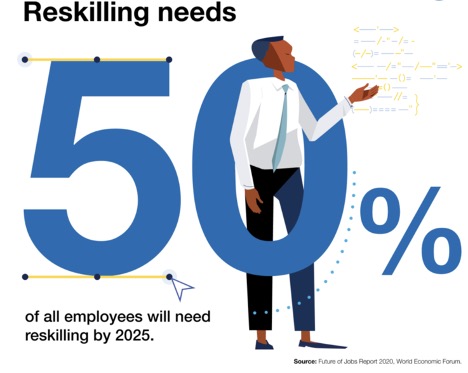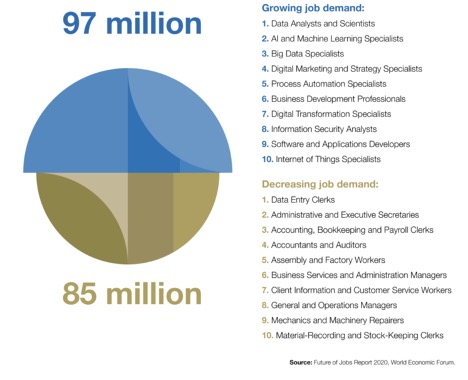A very interesting report was just released from the World Economic Forum. It highlights something that I’ve been saying for a few years, but which is really significant today: without automation no company is going to make it into the future.
One prediction made by the report is that, by 2025, 15 percent of the human workforce will be reduced, replaced by machines.

Another prediction is that also by 2025, 50 percent of the workforce will need to be reskilled.

You can see that between these two predictions, roughly half the workforce is going to be affected by advances in automation—either by being replaced or forced to reskill.
A considerable amount of manual work that is still being done in companies is rapidly becoming automated. An example given in the report is data entry clerks, part of a job demand that will decrease from 97 million to 85 million by 2025.

At Pipeliner, we are right with this trend with the Automatizer feature of Pipeliner CRM, because this is exactly what Automatizer does: makes it possible for companies to automate many of the tasks staff have been having to manually perform.
Exponential Growth
We can see that the trend in technology is most definitely exponential. We can simply look at the world’s largest repository for open source programming, GitHub, to see how true this is. In 2013, GitHub had 3 million users. Today, there are 40 million, in over 190 million repositories. This means that some 40 million programmers are working on all kinds of different code to make it better.
When putting together a program, it’s just a simple matter now to go and find a component that you need, such as a dashboard. You can simply pick it up and plug it into your program. For programmers, this very handy—and such components, being constantly worked on, only become better and better over time.
Not only are these components becoming better, but it could be said that none of them, because of this constant improvement, are low-quality. We could make a comparison to the auto industry, in which technology only becomes better and more powerful. Today, if you’re out shopping for a new car, there really are no inferior ones. When I was a teenager I had a VW bug that I worked on myself, and it had no air conditioner, no power steering or power brakes, no sunroof, no sound system—none of that. Today my car is almost like a spaceship, having all the amazing features that I couldn’t have even imagined in my old VW, and so are all the other new cars out there. Just like automobiles continue to become more robust, so do technology components.
Growing Without Staff
At Pipeliner, our contribution to this technology trend is to create a way for processes to be automated for sales, with no coding. With Automatizer, we’re offering a supremely easy workflow tool—which is actually an automation growth engine. With it you can integrate any cloud application into your workflow, for scalable processes in your organization.
As we see in the World Economic Forum report, an increasing number of humans will be replaced by technology tools such as Automatizer, over the next 5 years. That means that when a company has a successful business model, it can grow exponentially without adding a lot of staff.
Finance models for business will be changing too, as traditionally they were based on staffing offices and creating infrastructure around the staff. This got rather ridiculous, with enormous “super-cool” staff environments with rooms for employees to rest in, to play in, to think in. I think that covid19 has done away with that model, probably on a permanent basis. Companies figured out, once such infrastructures couldn’t be used anymore, that they really weren’t needed.
In fact, company offices are no longer required at all. Staff are provided the flexibility to work wherever they are located. All that is required is an infrastructure in which staff can connect and communicate.
Change We Must
This is a great deal of change, brought about very rapidly. Some people are overwhelmed by it. We know that some folks are not open to change; it’s difficult for them, and they’d rather stick with the old system.
Change can certainly be difficult. Just remember growing up, the physical changes we had to struggle through, followed by suddenly being alone in the world and having to survive. Change comes upon us, but it is not something we take to naturally. There’s always a little part of us that wants to hang onto what came before. It’s the mindset that really must change.
But change we must. Not so long ago, humans were working in factories. Today, most factory workers have been replaced by robots. And as we’ve seen, more and more work will be taken on by automation, which will have drastic implications on our lifestyles. These implications will help us redefine what real work is.
Defining Processes
Helping us redefine real work are tools such as Automatizer. But before you can create processes with something like Automatizer, you must define those processes. We could take a super-simple example of process definition in cleaning a house. People today—and throughout time, really—when they had a bit of money, want to hire someone to clean their home. But when the new house cleaner shows up, you’re going to have to give them a process. Do they start with the bathroom? The bedrooms? The living room?
Automated processes in a company must likewise be defined. The challenge of the future is, who is doing the defining, and what kind of skills do they need? As an example, in a virtual company, there’s no longer a person there answering the phone. How is the phone answered? When there is a message coming in, how is it responded to? There are “virtual secretaries” out there, and Pipeliner uses them, too. But all of these processes must be defined.
In sales, once processes have been defined, you can use Automatizer to simply create them with drag-and-drop.
To begin with, simple processes can be created. You certainly don’t have to start with multiple complex processes, such as those created by Amazon (Can you imagine the processes behind being able to place an order and having it delivered the same day, sometimes within hours?). I believe such processes are only the beginning, and we’ll see many more in the next 2 to 3 years that are even more incredible.
But let’s start easy. And we’ve certainly made it easy with Automatizer.





















Comments (2)
great content
Great Article